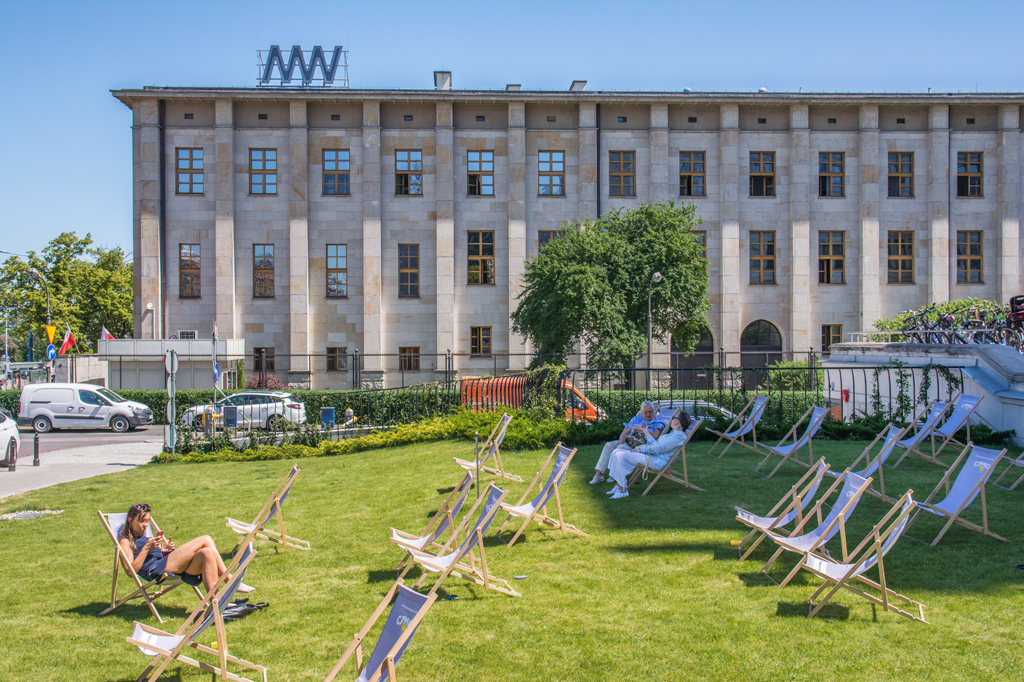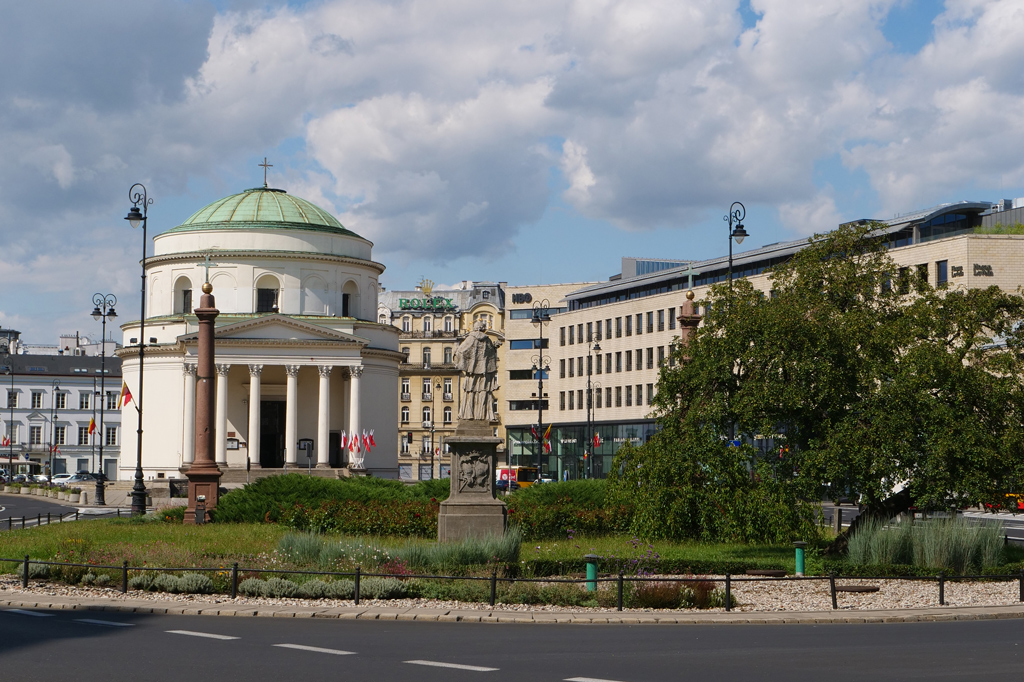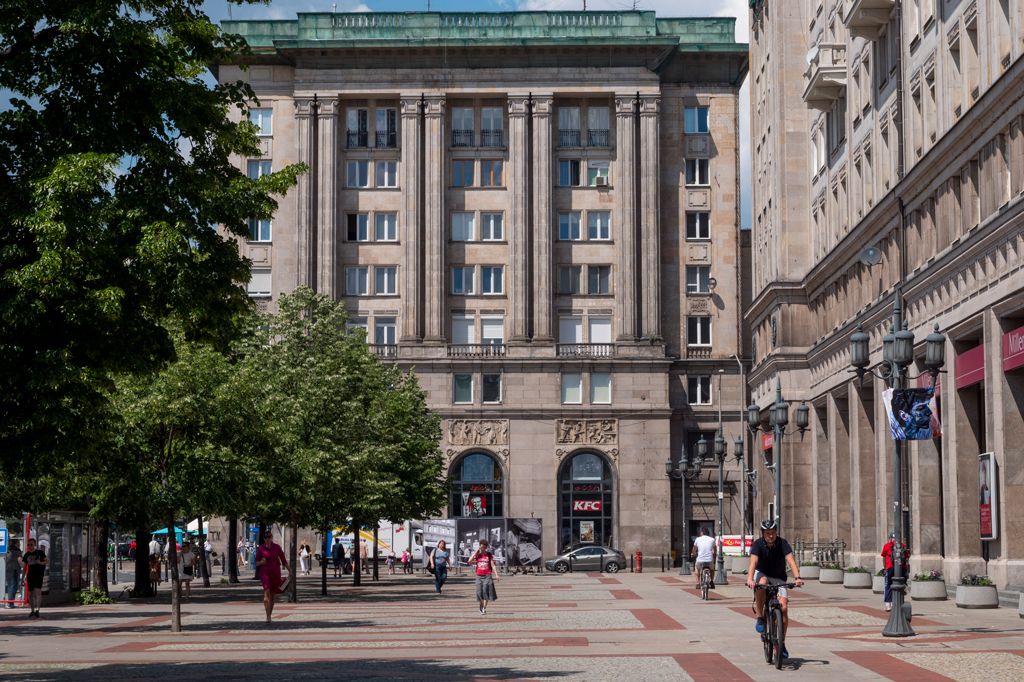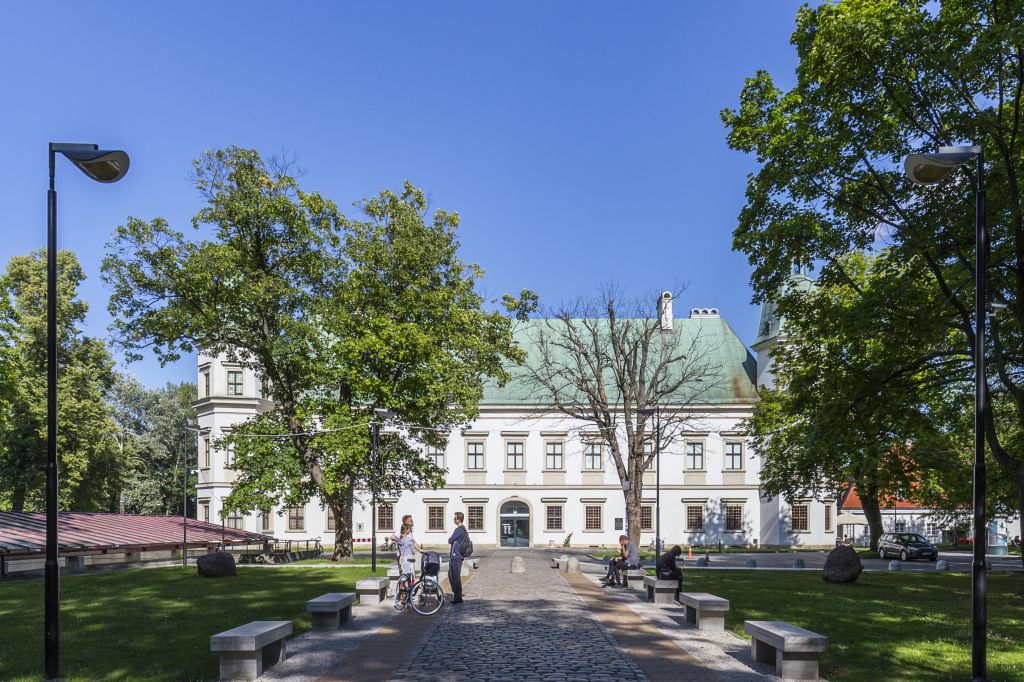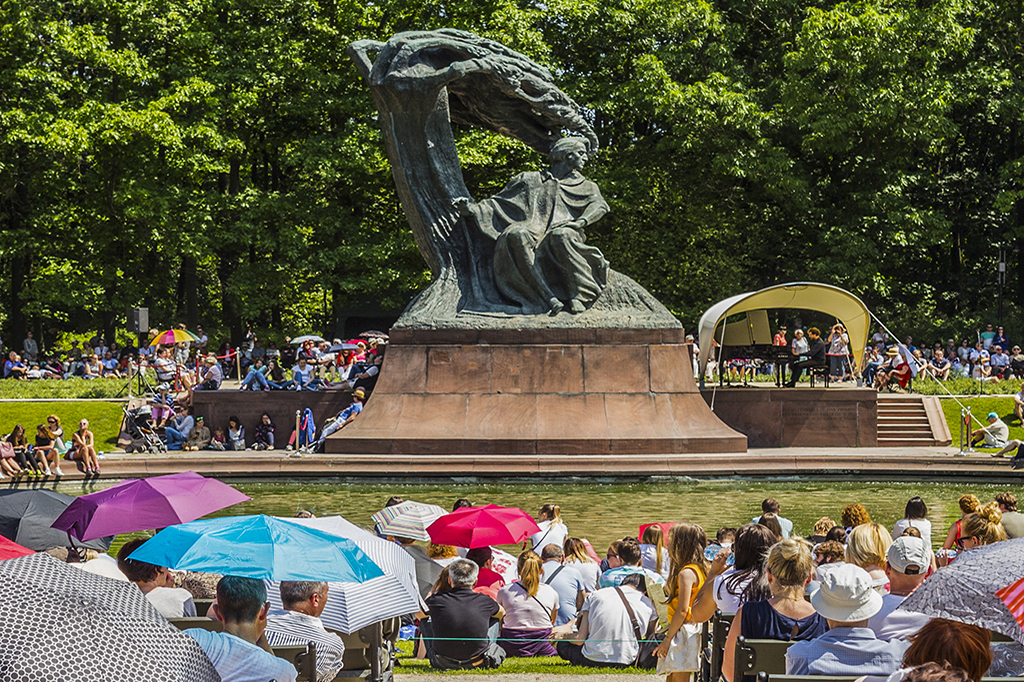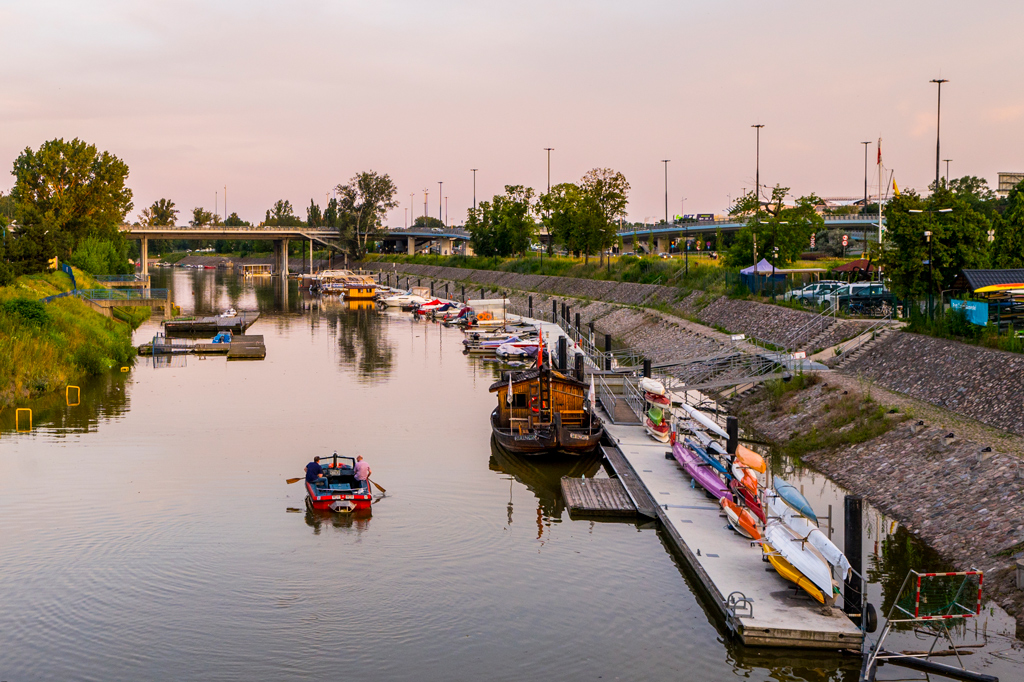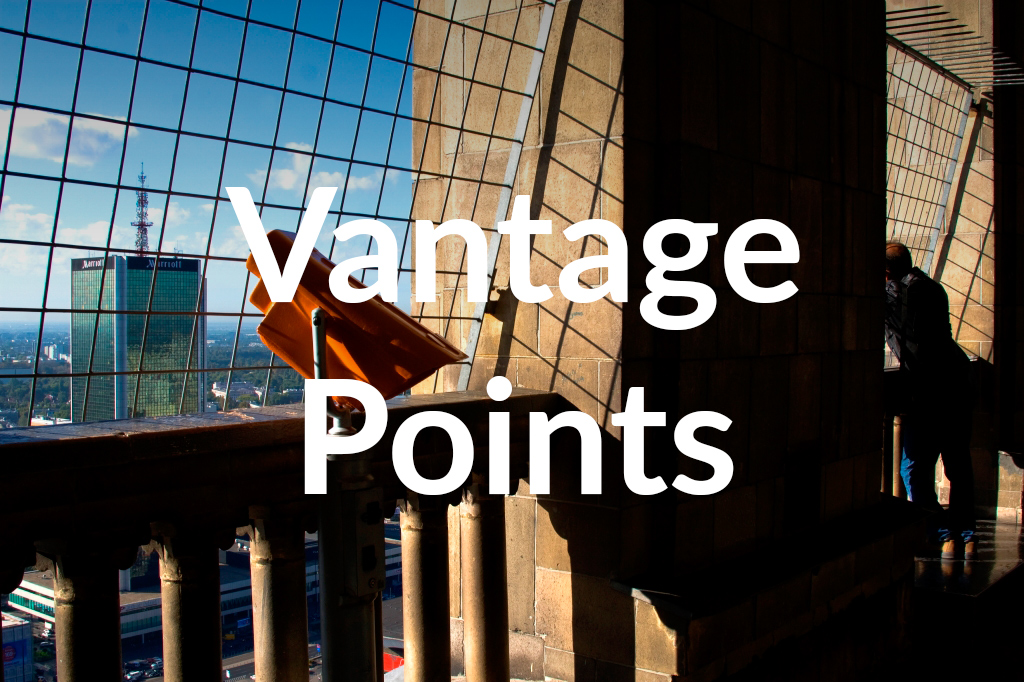Walk around Śródmieście district – part 2
You’ll find a lot of interesting things to do and see in the city centre south of Jerozolimskie Avenue. Beautiful buildings that survived the Warsaw Uprising can be seen here, along with popular parks, the socialist realist Marszałkowska Residential District, a slew of museums, and the lively Zbawiciela Square, a popular gathering spot for students and young professionals. If you think the history of the capital begins in the Old Town, you’re wrong; you should also check out the site of Jazdów, a fortified town that predates Warsaw. There is much to enjoy on this fascinating expedition.
Jerozolimskie Avenue and Its Surroundings
The first leg of your stroll through Śródmieście took you north of Jerozolimskie Avenue. Now, let’s take a look at the southern side of this major thoroughfare. Continue along the avenue towards the Poniatowskiego Bridge, where there is the National Museum, housed in a magnificent building from the 1930s. Wonderful works of art by Polish and international artists can be found inside. It also houses Europe’s largest collection of Nubian art from the eighth to the fourteenth century, including a unique collection of wall paintings.
After visiting the museum, head back towards the Charles de Gaulle Roundabout, where a statue of the celebrated French general stands in front of the former headquarters of the Central Committee of the Communist Party. Once communism gave way to capitalism, the grand Party Building housed the Stock Exchange, the new system’s most important economic institution. It is now filled with hip cafes and bars, so if you need a relax in true Warsaw fashion, this is the place to go.
After a short break, walk south along Nowy Świat towards Trzech Krzyży Square, or Three Crosses Square. Its name is derived from the crosses that are the remains of the Calvary Road, founded in the 18th century by King Augustus II. It ran along today’s Ujazdowskie Avenue to the vicinity of Ujazdowski Castle. Two gilded crosses stand in the southern part of the square and a third is held by St John of Nepomuk, located between them. Take a look at St Alexander’s Church, which is the focal point of the square.
It was built in the 1820s according to a design by Piotr Aigner and is full of similarities to the Roman Pantheon. The church was demolished in 1944 and elaborately rebuilt after the war.
Also, go to the point where Trzech Krzyży Square joins Bracka Street. The 19th-century Griffin building, also known as the Fuchs House, stands there. Before the war, it was considered one of the most beautiful neo-Renaissance buildings in Warsaw.
Marszałkowska Residential District and Its Surroundings
Take a southerly stroll down Mokotowska, where you’ll find upscale boutiques and excellent eateries, and then make a left onto Koszykowa. It will take you to the Marszałkowska Residential District, or MDM. This is a very different part of Śródmieście, built between 1950 and 1952 in the Socialist Realist style. Look out for the monumental residential buildings, sculptures of model socialist workers and giant candelabra-style street lamps. Housing for 45,000 people was originally intended to be built, but due to a lack of funding, only a portion of the project was finished.
In the evening, keep an eye out for one of Warsaw’s iconic 1960s neon signs on the square – the ‘Volleyball player’.
MDM is the ideal location for the Museum of Life in the People’s Republic, which is located on Piękna Street. The museum’s exhibits evoke the memory of times of shortages in shops, militiamen on the streets and long-forgotten everyday objects.
What else might be of interest to see nearby? For instance, Hala Koszyki, one of many market halls in Warsaw constructed at the turn of the 20th century. The structure was destroyed during the Warsaw Uprising, and despite being rebuilt after the war, it never recovered its former grandeur. Only in the twenty-first century, as a result of its revitalisation, has Hala Koszyki evolved into one of Warsaw’s most important food halls in the city, where you can sample cuisine from all over the world.
There is another noteworthy structure in the area – the Main Building of the Warsaw University of Technology on Politechniki Square. It was built in 1900 and opened two years later. Reportedly, its architects visited six countries in three weeks to seek inspiration for their project. Although it doesn’t seem like much of a journey today, it must have been a crazy expedition at the turn of the 20th century. Make sure to enter the building to discover a world resembling Hogwarts, complete with mysterious staircases and balconies. The auditorium’s towering glass mosaic roof is another feature that is certain to impress you.
You can reach the renowned Zbawiciela Square from Nowowiejska Street, which runs east of Politechniki Square. Young Varsovians love the square because of its many restaurants and clubs. Zbawix, or Hipster Square, as it is also known, is the ideal location for a party. There are also several cultural institutions in the area, including two theatres: Teatr Współczesny and Teatr TR, and the Comedy Club, which hosts stand-ups. Spend some time in the square unwinding before coming back preferably at night to fully take in the atmosphere.
Jazdów, Ujazdów…
From Zbawiciela Square walk along Wyzwolenia Avenue to Na Rozdrożu Square. This is your launch pad to start exploring the green part of the city centre. First, stroll through Ujazdowski Park and then, when you reach the back, see the amazing Jazdów estate. Here, immediately after the war, 90 small wooden Finnish houses were assembled from prefabricated components. Many such buildings came to Warsaw from the Soviet Union, which in turn received them from Finland as war reparations. The cottages, which were supposed to be demolished in 1955, housed employees of the city’s post-war reconstruction office. Today, some of them are still standing, some of them are even still inhabited, and some of them serve as the base for numerous cultural and social organizations that host numerous events and gatherings every year.
Cross the footbridge over Łazienkowska Thoroughfare (Trasa Łazienkowska) and you will reach Ujazdowski Castle. It was in this area that the fortress of Jazdów existed from the 12th century, guarding the nearby ford across the Vistula. The castle was destroyed during a Lithuanian invasion in 1262 and fratricidal fighting in 1281. As a result, the fortress was moved further downstream, where today’s Old Town is. As a result, Warsaw can be said to have originated from the Jazdów fortress. Ujazdowski Castle was built in 1624, on the site of a wooden manor house. It was burnt down during the Warsaw Uprising and razed to the ground after the war. Rebuilt in the 1970s, it has been the home of the Centre for Contemporary Art since 1985.
Be sure to stand on the terrace of the castle, just above the Warsaw Escarpment where you will be able to see Agrykola Park with the Piaseczno Canal, built in the mid-18th century, leading towards, the Legia Warsaw stadium visible in the distance. After that, head to the charming Agrykola Street, which descends to the Vistula valley and is illuminated by gas lamps.
Royal Łazienki and Its Surroundings
At the point where Agrykola Street stops going downhill, on the right is one of the entrances to Warsaw’s most beautiful park, Royal Łazienki. However, we encourage you to carry on a little bit to the bridge over the Łazienki Lake, near the statue of Jan III Sobieski. It offers a magnificent view of the palace, which sits on its artificial island. Just beyond the lake, you will find the next entrance to the park, and the path leads directly to the centre of the park.
This park is a palace and garden complex founded in the 18th century by the last king of Poland, Stanisław August Poniatowski, on the site of the former Lubomirski hunting ground. It was the summer residence of the king, who spent the warm months here. Most of the historic buildings are in the area around Łazienki Lake, which is the axis of the park. The park features charming gardens, including royal, romantic, modernist, and Dutch gardens. You can walk for hours in Łazienki, discovering its historical treasures and the nature that has grown here for centuries. A major attraction are the summer Sunday open-air concerts that take place right next to the Fryderyk Chopin monument. Chopin’s greatest works are performed by artists from all over the world each Sunday at 12.00 and 16.00.
Adjacent to Łazienki Park from Ujazdowskie Avenue and Belwederska Street are the Botanical Garden of Warsaw University and Belwederski Palace. If you still have some energy left after a long walk in Łazienki, you should go and see them. The Botanical Garden, founded in 1818, is well worth a stop in spring or summer to see the local plant collection.
The Belvedere Palace is a historic building whose history dates back to the mid-16th century. The name probably derives from the Italian words ‘bel vedere’, meaning beautiful view. The palace has changed owners many times over the centuries and has been the residence of the Polish president since 2010. To see inside the palace, you have to go on one of the organised tours that take place on the last Saturday of the month at 10.00. You will find a Józef Piłsudski exhibition inside, as well as the Belvedere Chapel, Marshal Piłsudski’s former study, a room devoted to the Order of Virtutti Militari, and other historical spaces.
Solec and Czerniaków
The part of the city centre situated on the plateau was wealthy and metropolitan. However, next to the Vistula where each year there was a risk of floods, the city looked very different. There, it was poor and industrial, with many wooden buildings, and often in a dangerous state of repair. Czerniaków, of which Solec is a part, was one of the most run-down areas of Warsaw before the war. The name Solec is linked to the trade in salt, which was brought here by ship from southern Poland. In the days before refrigerators, salt was one of the few means of food preservation, and Warsaw always used a lot of it. The great flood of 1813 was the impetus for strengthening the riverbanks and building dikes. From then, the newly secured district started to become industrialised.
The area saw intense fighting in September 1944 during the Warsaw Uprising because it was the last link between insurgent Warsaw and the Vistula, through which aid from the Soviet Army was anticipated in vain. The wartime destruction in Czerniaków between Jerozolimskie Avenue and Łazienkowska Thoroughfare was so great that few of the original buildings survived and part of the district was turned into a park. One of the few remnants of the former Solec is the salt warehouse building at 63 Solec Street.
About a kilometre away is the Earth Museum, where you can see the collection of minerals, rocks, amber and meteorites, the largest in Poland. The Pniewski Villa, which is part of the museum, was the site of fighting during the Warsaw Uprising. In the building there is a marble staircase stained with the blood of an insurgent.
There is another interesting museum at 24 Solec Street, the Asia-Pacific Museum. There, you can see items from numerous exotic locations.
Czerniakowski Port
We suggest you end your walk in the area at Czerniakowski Port, a serene, lush, and fascinating location. It was built in 1904 on the site of a former oxbow lake of the Vistula and was a winter haven for steamboats seeking shelter from the Vistula flooding. There were also boat repair shops in this area, and the ramps used to launch ships are still there today. Boatbuilding came to an end here in the 1960s.
Forgotten for a long time, the port has recently come back to life. Numerous boats (including wooden schooners), motorboats, a houseboat, a restaurant barge and in winter a floating sauna are moored here. Several sports clubs, including beach volleyball, make use of the nearby green spaces. In the summer season, you can take a flat-bottomed boat, a speedboat or the glass iBarka from the nearby Czerniakowski headland. Continuing along the riverside boulevard towards the Poniatowski bridge, you will come across a cluster of bars and clubs that are open in the summer. Spend a relaxing evening at any one of them.

